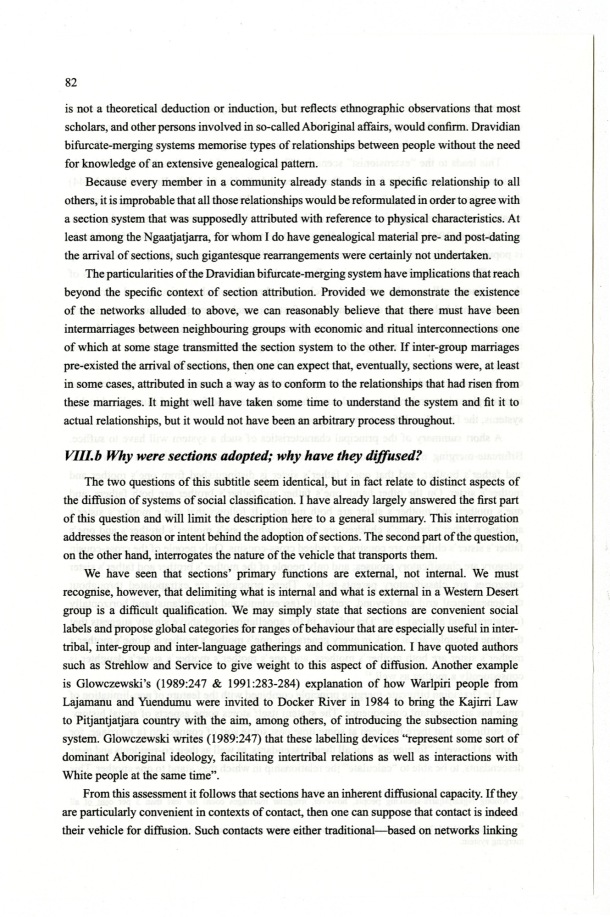|
| 
[Note: this transcription was produced by an automatic OCR engine]
82
is not a theoretical deduction or induction, but reflects ethnographic observations that most
scholars, and other persons involved in so-called Aboriginal affairs, would confirm. Dravidian
bifurcate-merging systems memorise types of relationships between people without the need
for knowledge of an extensive genealogical pattern.
Because every member in a community already stands in a specific relationship to all
others, it is improbable that all those relationships would be reformulated in order to agree with
a section system that was supposedly attributed with reference to physical characteristics. At
least among the Ngaatjatjarra, for whom I do have genealogical material pre- and post-dating
the arrival of sections, such gigantesque rearrangements were certainly not undertaken.
The particularities of the Dravidian bifurcate-merging system have implications that reach
beyond the specific context of section attribution. Provided we demonstrate the existence
of the networks alluded to above, we can reasonably believe that there must have been
intermarriages between neighbouring groups with economic and ritual interconnections one
of which at some stage transmitted the section system to the other. If inter-group marriages
pre-existed the arrival of sections, then one can expect that, eventually, sections were, at least
in some cases, attributed in such a way as to confomr to the relationships that had risen from
these marriages. It might well have taken some time to understand the system and fit it to
actual relationships, but it would not have been an arbitrary process throughout.
VIII.b Why were sections adopted; why have they difl'used?
The two questions of this subtitle seem identical, but in fact relate to distinct aspects of
the diffusion of systems of social classification. I have already largely answered the first part
of this question and will limit the description here to a general summary. This interrogation
addresses the reason or intent behind the adoption of sections. The second part of the question,
on the other hand, interrogates the nature of the vehicle that transports them.
We have seen that sections’ primary functions are external, not internal. We must
recognise, however, that delimiting what is internal and what is external in a Western Desert
group is a difficult qualification. We may simply state that sections are convenient social
labels and propose global categories for ranges of behaviour that are especially useful in inter-
tribal, inter—group and inter-language gatherings and communication. I have quoted authors
such as Strehlow and Service to give weight to this aspect of difl‘usion. Another example
is Glowczewski’s l989:247 1991 2283-284 explanation of how Warlpiri people from
Lajamanu and Yuendumu were invited to Decker River in 1984 to bring the Kajini Law
to Pitjantjatjara country with the aim, among others, of introducing the subsection naming
system. Glowczewski writes 1989:247 that these labelling devices “represent some sort of
dominant Aboriginal ideology, facilitating intertribal relations as well as interactions with
White people at the same time”.
From this assessment it follows that sections have an inherent diffusional capacity. If they
are particularly convenient in contexts of contact, then one can suppose that contact is indeed
their vehicle for diffusion. Such contacts were either tr-aditional—based on networks linking
|